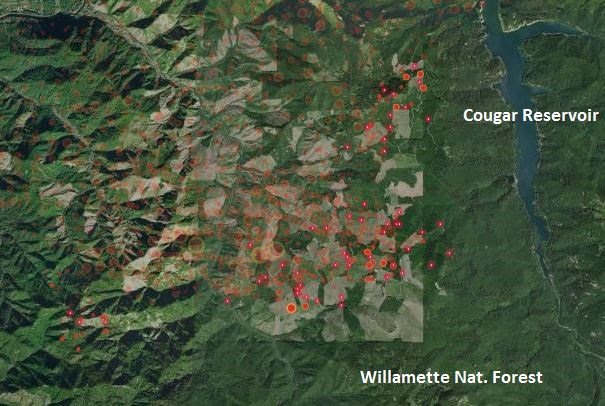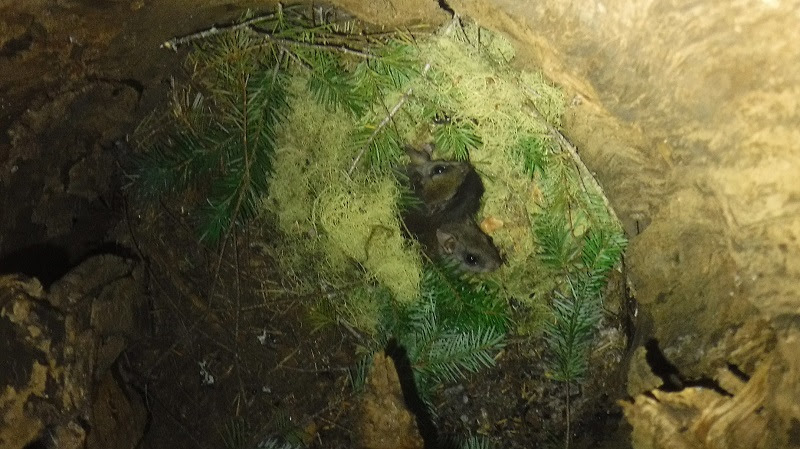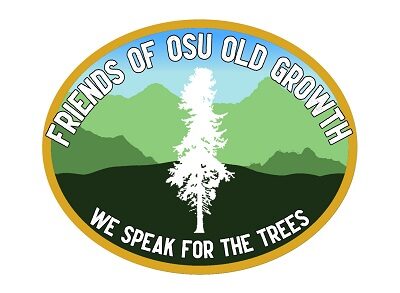(this email update was sent to Friends supporters on Sept. 15th, 2020)

Dear Friends of OSU Old Growth,
It’s hard to believe that only a week and a half ago, my family and I were hiking in the majestic old growth of Silver Falls State Park. As we climbed out of the cool canyon at the end of our hike, the air began to fill with smoke. We had noticed several charred fields on our drive to the park and assumed farmers must be burning more crop stubble. We never imagined the enormous devastation that would soon follow. When I heard the news of Oregon’s wildfires on the BBC news the other night, the magnitude of our local tragedy really sank in. Our fires were no longer “just” national news, they had become a world headline.
The bulk of the media coverage has understandably focused on evacuation orders, destruction of towns, and the tragic loss of life. With the absence of details, many of us are imagining the loss of natural areas that we hold dear. We wonder how much old growth has burned and whether cherished natural areas (like Silver Falls) will come through unscathed. Some are already anticipating the inevitable push by the timber industry and their Forest Service proxies to salvage timber from fire-damaged forests. With all of the concerns and uncertainty, some perspective and context may be helpful.
Fire is Part of Nature: For millennia, fire has shaped the ecology of our region providing a complex tapestry of habitats and biodiversity. One of our nation’s leading experts on old growth forests recently reminded me that the 400-500 year old trees killed in these fires will last another 400-500 years before they fully decompose. They’ve only reached the halfway point of their existence. The vast majority of fires only burn a small percentage of the available biomass. The charred trunks and roots will continue to store carbon and provide essential habitat and ecological services for centuries to come.
Historical Context of “East Wind Event” Fires: While the loss of life and property may be unprecedented, these types of fires are not. Oregonian reporter Ted Sickinger’s recent article provides some excellent historical context. I highly recommend it:
https://www.oregonlive.com/news/2020/09/oregons-historic-wildfires-the-unprecedented-was-predictable.html
He points out that large “east wind event” fires have occurred many times since people of European descent first settled in Oregon. His article also explains why thinning is NOT the solution to reducing wildfire risk (at least not on the west side of the Cascades). It’s important to note this contradicts one of the primary conclusions of the Governor’s Wildfire Council (chaired by former timber company executive, Matt Donegan). While the Council’s 2019 report advocated spending $4 billion to treat 5.6 million acres of forest and grasslands, experts insist thinning and cutting trees won’t prevent these types of fires.
Intensively Managed Forest Lands Burn with More Intensity: A significant body of research has shown a strong link between managed (private) forest lands and wildfire intensity. A 2018 study by OSU researchers found that, “Intensively managed private forestlands tended to burn with greater severity than older state and federal forests…even after accounting for the age of forested stands…” You can find a nice summary of the OSU research here: https://today.oregonstate.edu/news/high-wildfire-severity-risk-seen-young-plantation-forests
This research is yet another reason to question OSU’s reliance on industrial forestry practices in the McDonald-Dunn Research forests. If the OSU forests ever experience a catastrophic wildfire event, it unfortunately won’t come as a surprise.
The connection between industrial forests and fire intensity can be clearly seen in the images of the Holiday Farm Fire (east of Eugene) above and below. The orange and red circles show the cumulative fire activity and current hotspots. The mosaic of industrial forest lands stands in stark to the older, dark green reserves of the Willamette National Forest. The National Forest lands appear to have significantly less fire damage than the adjacent private timber lands. Definitive analysis will have to wait until the Forest Service is able to survey for fire damage and publish the results. Still, it’s encouraging to see that large tracts of mature forest appear to be intact (for now).

The Future of Oregon’s Old Growth: Even before the current wildfire season began, the Forest Service had begun a serious assault on our old growth forests. Large cuts planned for the Quartzville Middle Santiam and Upper McKenzie regions have broken decades of precedent protecting older stands. These moves appear to be prompted by pressure from the current, regressive administration via the Secretary of Agriculture (who oversees the Forest Service).
With extensive wildfire damage and other impacts of climate change, we can expect to see strong efforts by the Forest Service to allow salvage logging in coming years. After 26 years of the Northwest Forest Plan, most people had assumed the days of cutting old growth were behind us. Unfortunately, the US Forest Service seems stuck in the previous century. The current threats to old growth should motivate us all to fight even harder for the remaining ancient forests. Our advocacy for old growth protection, whether it be in the OSU Research Forests, the Elliott State Forest, or beyond – couldn’t be more timely and important!
Thanks for your continued support!
Doug & Friends of OSU Old Growth (www.friendsofosuoldgrowth.org)

